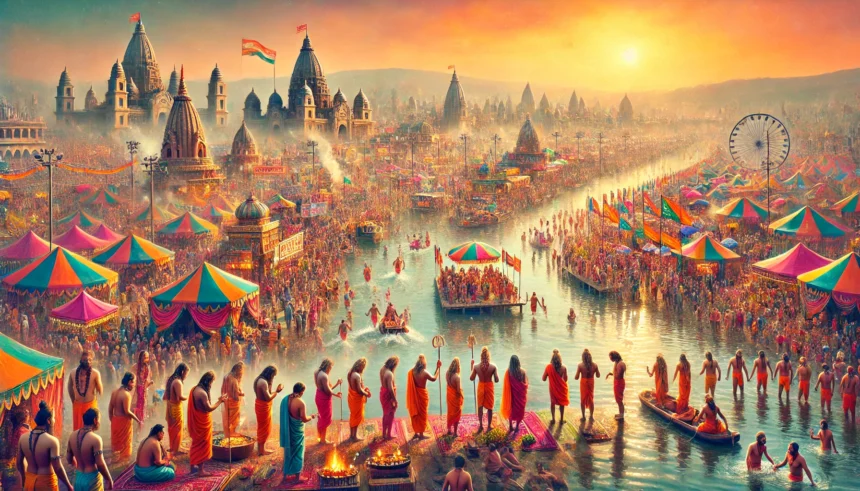The Rare Maha Kumbh Mela: Why It Happens Every 144 Years and Its Impact on Daily Life
Maha Kumbh Mela is a once-in-a-lifetime event for many, occurring every 144 years at the confluence of India’s most sacred rivers. Known as the Sangam, the meeting point of the Ganga, Yamuna, and the mythical Saraswati rivers, this gathering is steeped in spirituality, history, and cultural significance. The Maha Kumbh Mela, unlike the regular Kumbh Melas, is of rare cosmic alignment and immense religious importance, attracting millions from across the globe.
Why Does the Maha Kumbh Mela Happen Every 144 Years?
The Maha Kumbh Mela is based on the astrological alignment of celestial bodies. According to Hindu mythology, the event marks the cosmic battle between gods and demons for the nectar of immortality (amrit), during which drops of the nectar fell at four locations in India—Allahabad (Prayagraj), Haridwar, Nashik, and Ujjain.
The Maha Kumbh Mela’s 144-year cycle is tied to a unique planetary alignment that is considered exceptionally auspicious. It is distinct from the Purna Kumbh (held every 12 years) and other Kumbh variants. This rare event magnifies the spiritual merit (punya) of taking a holy dip at the Sangam, drawing immense crowds of saints, ascetics, and pilgrims.
Impacts on Daily Life
- Economic Boost: Local economies thrive as millions of pilgrims and tourists flock to the region, creating jobs in hospitality, retail, and transport.
- Spiritual Renewal: For devotees, the event provides a deep sense of peace, renewal, and connection to their faith.
- Infrastructure Development: Massive investments in temporary housing, sanitation, healthcare, and security improve the region’s infrastructure.
- Environmental Awareness: The event highlights the importance of preserving sacred rivers, often inspiring clean-up campaigns.
Historical Background of the Maha Kumbh Mela
The Maha Kumbh Mela’s origins are rooted in Hindu mythology and the story of the Samudra Manthan (churning of the ocean). Legend says the gods and demons churned the ocean to retrieve the nectar of immortality, spilling it at the four Kumbh Mela locations. Historical records suggest that the tradition of Kumbh gatherings dates back over 2,000 years, with references found in ancient texts such as the Rigveda and accounts by Chinese traveler Hiuen Tsang in the 7th century.
7 Fascinating Facts About the Maha Kumbh Mela
- Largest Gathering: It’s the world’s largest human gathering, with over 100 million attendees during some years.
- Sacred Dip: Devotees believe bathing in the holy rivers during the Maha Kumbh cleanses sins and paves the way to moksha (liberation).
- Unique Alignments: The event’s timing is determined by the rare alignment of Jupiter, the Sun, and the Moon in the zodiac of Aquarius.
- Global Participation: Pilgrims and spiritual leaders from across the world attend, transcending geographical and cultural boundaries.
- Temporary City: A massive temporary city is built to accommodate millions, complete with sanitation, hospitals, and roads.
- Sects Unite: It brings together various Hindu sects, including Shaivites, Vaishnavites, and Naga Sadhus, fostering unity in diversity.
- Cultural Showcase: The event is a vibrant display of India’s rich heritage, from classical music to traditional art forms.
Significance of the Maha Kumbh Mela
- Spiritual: The Maha Kumbh Mela is considered a gateway to divine blessings, self-purification, and liberation.
- Cultural: It’s a living repository of India’s spiritual traditions and practices.
- Social: The event fosters a sense of global unity and shared humanity, as millions gather with a common purpose.
How to Observe the Maha Kumbh Mela
- Participate: Attend the Mela to experience the spiritual and cultural grandeur firsthand.
- Holy Dip: Take a ceremonial bath in the sacred rivers during auspicious times.
- Volunteer: Contribute to organizing the event or helping pilgrims.
- Spread Awareness: Share the significance of this rare event through social media, articles, and discussions.
- Embrace Sustainability: Advocate for eco-friendly practices to protect the rivers and environment.
Wishing Devotees and Observers
- “May the Maha Kumbh Mela bring you peace, blessings, and a sense of divine connection.”
- “Celebrate the rarest event of 144 years by immersing in spirituality and unity.”
FAQs About the Maha Kumbh Mela
Q: Why is the Maha Kumbh Mela so rare? A: It occurs every 144 years due to a unique planetary alignment believed to amplify spiritual benefits.
Q: Who attends the Maha Kumbh Mela? A: Pilgrims, saints, ascetics, and tourists from across the world.
Q: What preparations are made for the event? A: Temporary cities with extensive facilities, including tents, sanitation, healthcare, and food, are constructed.
Q: Can non-Hindus participate? A: Yes, the event is open to people of all faiths interested in learning about or experiencing its cultural and spiritual significance.
Q: What’s the next Maha Kumbh Mela after 2025? A: The next Maha Kumbh Mela will occur in 2169, 144 years later.
Why Is It Important to Society?
The Maha Kumbh Mela underscores humanity’s shared values of faith, unity, and compassion. It reminds us of the need to preserve cultural heritage while fostering a spirit of coexistence. For individuals, it offers a chance to pause, reflect, and rejuvenate amidst the chaos of modern life.
The Maha Kumbh Mela is more than an event; it’s a celebration of faith, humanity, and the cosmic rhythms that bind us all. Let us honor this extraordinary tradition and embrace its message of unity and spirituality.
The Awe of 144 Years: 7 Key Facts About the Maha Kumbh Mela
The Maha Kumbh Mela is one of the largest and most significant religious gatherings in the world. It occurs once every 12 years at four different locations in India. Here’s an overview of 7 key facts about this awe-inspiring event:
1. The 144-Year Cycle
The Maha Kumbh Mela is celebrated every 12 years at each of the four sacred locations: Prayagraj (formerly Allahabad), Haridwar, Ujjain, and Nashik. However, the event at Prayagraj occurs once every 144 years, making it particularly special. The 144-year cycle is determined by an intricate alignment of celestial bodies and astrological factors.
2. Spiritual Significance
The Mela is believed to be a time when devotees can attain spiritual liberation (moksha) through rituals, bathing in the holy river, and seeking blessings. The gathering marks the alignment of the sun, moon, and Jupiter in specific astrological positions.
3. The Holy Dip
The central act of the festival is the “holy dip” in the river. Bathing in the river during the Mela is believed to purify sins and bring spiritual enlightenment. Millions of pilgrims gather at the banks of the sacred rivers for this sacred ritual.
4. The Kumbh Pot
The event gets its name from the “Kumbh” or pot, which is a symbolic representation of the pot of nectar (amrita) that appeared during the churning of the ocean in Hindu mythology. This pot is believed to have been spilled over four locations, where the Mela is held.
5. A Global Gathering
The Maha Kumbh Mela attracts millions of devotees, making it one of the largest gatherings of people in the world. It is not only a religious event but a global cultural phenomenon, drawing tourists and scholars interested in Hindu traditions, spirituality, and culture.
6. Naga Sadhus
A prominent feature of the Mela is the procession of Naga Sadhus—ascetic monks who are known for their nakedness and mystical practices. They play a central role in the ceremonial rituals and mark the beginning of the Mela with their grand procession.
7. Cultural and Social Impact
Beyond its religious significance, the Maha Kumbh Mela also has a profound cultural and social impact. It provides a platform for people to connect, exchange ideas, and experience a sense of unity and devotion that transcends geographical and social barriers.
The Maha Kumbh Mela remains an awe-inspiring display of faith, culture, and tradition, drawing people from all walks of life to experience a spiritual journey of a lifetime.










